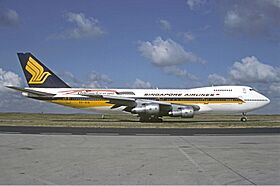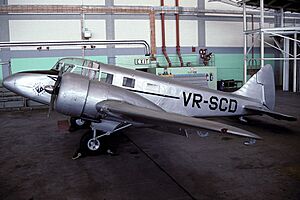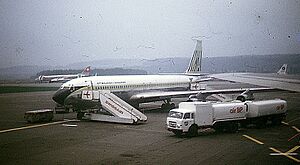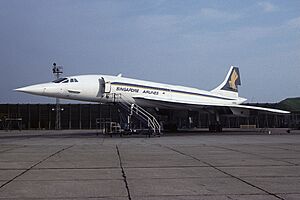History of Singapore Airlines facts for kids
This article tells the story of Singapore Airlines, often called SIA or SQ. It's the main airline for Singapore and flies from Singapore Changi Airport. Singapore Airlines is known for being one of the best airlines in the world.
For over 20 years, it has been a 5-star airline, which is a top rating. It's also one of the biggest airlines in Asia. SIA flies to many places in Asia, Africa, Europe, the Middle East, and North America. Their famous slogan is "A Great Way To Fly". The airline is also special because its plane design hasn't changed much over the years. Plus, they have the well-known Singapore Girl flight attendants, who first appeared in 1972.
Contents
How it All Started
After World War II, a new airline called Malayan Airways began on May 1, 1947. This was a big step for air travel in Southeast Asia.
Malayan Airways was started by a few companies working together. Its first flight was a special trip from Singapore to Kuala Lumpur on April 2, 1947. Soon after, regular weekly flights began to places like Ipoh and Penang. They used small planes called Airspeed Consuls.
Through the 1940s and 1950s, Malayan Airways grew a lot. Other airlines helped them with technical advice. By 1955, they had many Douglas DC-3 planes. The company became public in 1957, meaning people could buy shares in it. Over these years, they used different types of planes, like the Douglas C-54 Skymaster, Vickers Viscount, and de Havilland Comet 4. This growth helped set the stage for two important airlines later on: Malaysia Airlines and Singapore Airlines.
In 1963, when Singapore joined Malaysia, the airline changed its name to "Malaysian Airways". It also took over another airline called Borneo Airways. In 1966, after Singapore became a separate country, the airline changed its name again to Malaysia-Singapore Airlines (MSA). The next year, MSA grew quickly. They bought their first Boeing 707 planes and built a new main office in Singapore. Soon, Boeing 737s were added to their fleet.
Becoming Singapore Airlines
In 1972, MSA split into two new airlines: Singapore Airlines and Malaysian Airlines System. Singapore wanted to fly to more international places, while Malaysia wanted to focus on flights within its own country first. Singapore Airlines kept all of MSA's Boeing 707s and 737s. It also kept the international routes from Singapore and the main office in the city.
The female flight attendants continued to wear their special sarong kebaya uniform, which had started in 1968. An advertising company helped make these flight attendants famous. They called them the Singapore Girls, and they became a symbol for the airline.
After the split in 1972, SIA grew very fast. They added new cities in Asia to their network. They also bought new planes, including the large Boeing 747s. The first two 747s arrived in 1973 and flew on busy routes like Singapore to Tokyo. By 1976, SIA had 21 Boeing planes. Their passenger network covered 28 cities in 23 countries, from London to Auckland. The smaller 737s flew regional flights, while the bigger planes flew longer routes. Flights to London were daily using 747s.
SIA also flew daily 747 flights to Tokyo and daily 707 flights to Osaka. Other flights went to Jakarta, Bangkok, and Hong Kong. The 707s were used a lot for many passenger flights each week. One 707 was even used just for cargo flights to places like Amsterdam and Paris.
In 1977, SIA celebrated its 30th anniversary. They sponsored a car rally from London to Sydney. That same year, SIA ordered four McDonnell Douglas DC-10 planes. They also got their first Boeing 727-200 Advanced plane. In late 1977, SIA finally got approval to fly passenger services to the US. They started with three flights a week to San Francisco, stopping in Hong Kong, Guam, and Honolulu.
In December 1977, British Airways and SIA shared a Concorde plane for flights between London and Singapore. The plane was painted with both airlines' logos. However, the service stopped after only four days because of noise complaints from the Malaysian government. It started again on a new route that avoided Malaysian airspace. Then, India also had problems with the noise. The service was stopped for good in November 1980 because not enough people were flying on it.
SIA heavily advertised its new passenger flights to the US. They even painted "California here we come" on many of their planes. The US flights started in April 1979 using their new DC-10 planes. However, a plane crash involving another airline's DC-10 caused the US to ban all DC-10s from its airspace for a while. So, SIA had to use 707s for its US flights until new Boeing 747-200 'Super B' planes arrived in August 1979. SIA later sold all its DC-10s by 1983.
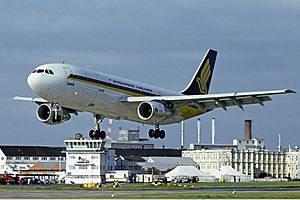
On May 12, 1981, Singapore Airlines made history. Its flight from London Heathrow was the very first nonstop flight from London to the new Singapore Changi Airport. This flight, SQ140, landed at midnight, making it the first commercial plane to arrive at the new airport.
The 1980s saw SIA move its main office to Changi Airport. The airline also expanded its flights to the United States, Canada, and more European cities. Madrid became the first Spanish city SIA served. They added Boeing 747-300 planes, called 'Big Tops', which replaced older 747s on long flights. They also added Airbus A310s and Airbus A300s. The A310s became important for flights within Asia. In 1989, SIA added the first of 50 Boeing 747-400s. The Airbus A340-300s helped with long flights to places like Spain and Zürich. In the 1990s, SIA started flying to southern Africa, including Johannesburg. Terminal 2 at Changi Airport opened in 1991, and all SIA flights moved there.
The Twenty-First Century
Key Developments

In 2004, SIA started nonstop flights from Singapore to Los Angeles and Newark in the US. They used the Airbus A340-500 for these flights. The flight to Newark was the longest scheduled commercial flight in the world, lasting about 18 hours. Singapore Airlines changed these planes to have only business class seats for these long routes.
On October 25, 2007, SIA's first double-decker Airbus A380 flew its first passenger flight from Singapore to Sydney. The A380 is a very large plane. Singapore Airlines is one of the biggest users of the A380. SIA uses the A380 for flights to major cities like London, Zürich, Paris, Sydney, and New York. The airline is also a key member of the Star Alliance, a group of airlines that work together.
In 2009, SIA stopped its flights to Vancouver, Canada, because fewer people were flying due to a worldwide money crisis.
Sometimes, airlines face challenges when trying to expand. In 2006, the Australian government did not allow Singapore Airlines to pick up passengers in Australia and fly them to the United States. This was to protect their own airline, Qantas, from more competition. SIA had faced similar issues before, for example, when they couldn't fly their large Boeing 747-400s to Jakarta because Garuda Indonesia complained.
Between 2008 and 2012, Singapore Airlines and another airline were fined by the South African Competition Commission. This was because of an investigation into how they set ticket prices.
On April 6, 2012, Singapore Airlines stopped using its last passenger Boeing 747 planes after 39 years. A special round-trip flight was made from Singapore to Hong Kong to celebrate. Passengers received special meals and gifts. The airline still uses 747s for cargo flights.
SIA also announced that it would stop its direct flights from Singapore to Newark and Los Angeles in 2013. However, Los Angeles would still be served with a stop in Tokyo. In 2015, Singapore Airlines announced they would be the first to use a new version of the Airbus A350, called the A350-900ULR, for "Ultra Long Range" flights. These flights began in October 2018 and brought back the nonstop service to the US.
SIA was also the first airline to receive the Boeing 787-10 plane on March 25, 2018.
The Airbus A380 Story
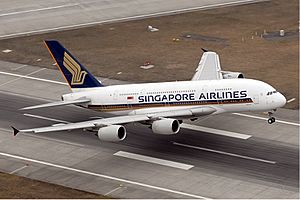
In September 2000, SIA announced they would order up to 25 of the new Airbus A3XX planes, which later became the A380. This was a huge order worth billions of dollars. In January 2005, the airline started using the slogan "First to Fly the A380 – Experience the Difference in 2006". They wanted to be the first airline to get the A380. However, Airbus announced delays due to technical problems. SIA's CEO was very unhappy about the delays.
In February 2006, the first A380 painted in Singapore Airlines colors flew to Singapore for a special show. On October 25, 2007, the very first commercial A380 flight, SQ 380, carried 455 passengers from Singapore to Sydney. It got a lot of attention from the news. The money earned from this special flight was given to charities. SIA began regular A380 flights on October 28, 2007, to cities like London, Tokyo, and New York.
By February 2009, SIA had carried one million A380 passengers. In 2012, SIA ordered five more A380 planes.
Changes to the Fleet
In February 2009, the airline announced it would remove 17 planes from its fleet. This was a way to save money because fewer people and less cargo were being flown during a global financial crisis.
Sponsoring Formula One
On April 15, 2014, Singapore Airlines became the main sponsor for the Singapore Grand Prix, a famous car race. They have continued to sponsor the event for many years, extending their agreement until 2024.
Merging with SilkAir
On May 18, 2018, Singapore Airlines announced that its smaller airline, SilkAir, would join the main company. SilkAir's planes would get new cabins, and its website was combined with Singapore Airlines' website. On January 28, 2021, SilkAir officially stopped operating as a separate airline and became part of Singapore Airlines.
The COVID-19 Pandemic Impact
Like many airlines worldwide, Singapore Airlines was greatly affected by the COVID-19 pandemic. As countries closed their borders, the airline had to cut flights by a lot, grounding about 138 planes. On the flights that still operated, everyone had to wear face masks.
Operations at Changi Airport were moved to one terminal to save costs. SIA offered full cash refunds for tickets bought during the pandemic. Passengers could also choose to get extra flight credits instead.
Many SIA employees, especially flight crew, had to take unpaid leave. Some even lost their jobs. Those who kept their jobs were allowed to work in healthcare or other important roles during the pandemic.
To help the airline financially, the Singapore government provided support. SIA also raised money by selling shares and bonds. In May 2020, Singapore Airlines announced its first financial loss in 48 years. The next year was even worse, with a record loss due to a huge drop in passenger traffic.
To help with safety, Singapore Airlines launched a special app. This app worked like a "Digital Health Passport" to store passenger information and COVID-19 test results for easier travel through airports.
Coming Back Strong
From June 2020, SIA slowly started flying to more destinations that were considered safe. Transfers between airlines within the SIA Group were allowed, and passengers were kept separate at Changi Airport. Over time, more destinations and flights were added.
In September 2020, SIA came up with creative ideas to earn money. They offered tours of their training facilities, special lunch services on grounded A380 planes, and even delivered meals to homes. Bookings for meals on the A380s sold out very quickly! Diners could choose different classes, from economy to suites, and enjoy international or local food.
Throughout 2021 and 2022, SIA gradually brought back flights around the world as air travel started to recover. Some destinations returned to having as many flights as before the pandemic. The number of people applying for cabin crew jobs also went back to normal levels.


